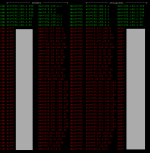SomeWhereOverTheRainBow
Part of the Furniture
That's a cool technique, I do something similar.I noticed that /etc/resolv.conf symlink changed with the tools Wan: use local caching dns option.
Code:/etc/resolv.conf -> /tmp/resolv.conf /etc/resolv.conf -> /rom/etc/resolv.conf
Since I have issues with ntp sync during startup, I added the following after NTP is ready. Not sure if this is ok. It seems to work.
Code:mount -o bind /rom/etc/resolv.conf /tmp/resolv.conf




